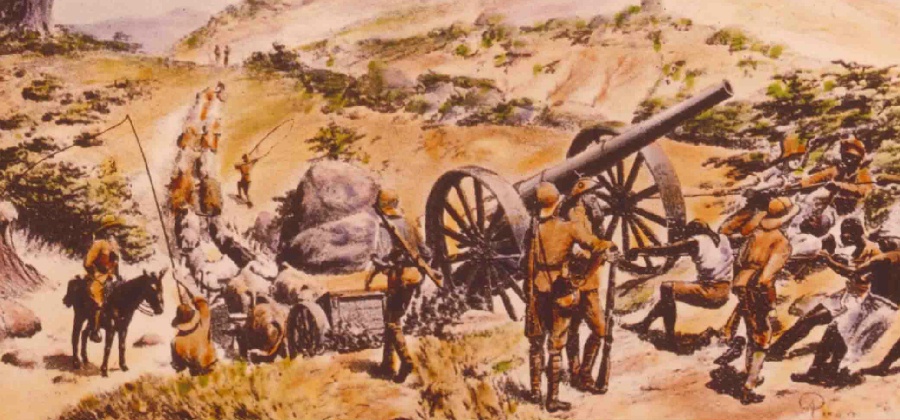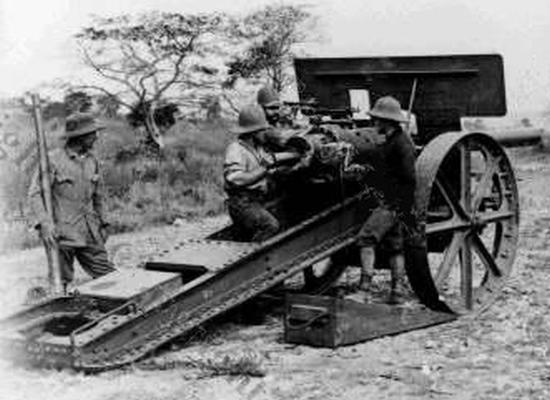|
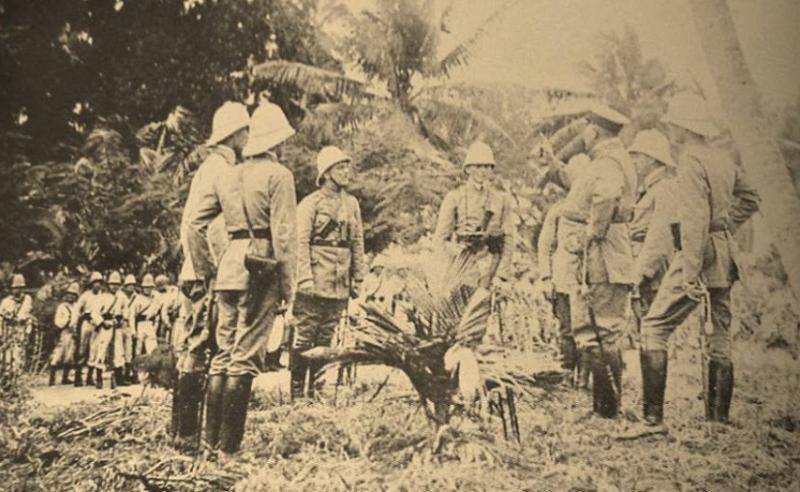
Looff addressing Königsberg officers
in the Rufiji Delta, 1915
Deployment of the Königsberg Guns
on Land
"The loss of the Königsberg
though sad in itself had at least this advantage for
the land campaign, that the whole crew and the
valuable supplies were now at the disposal of the
Schutztruppe."
(Quotation from
P85 'Reminiscences of East Africa' by Paul von
Lettow-Vorbeck, Naval &
Military Press Ltd 2004)
Salvage of
the Guns
As the
British Royal Navy had not been able to secure the
site of the Königsberg's wreck, the commander of the
Schutztruppe's Abteilung Rufiji, Korvetten-Kapitän
a.D. Werner Schönfeld took the initiative and ordered
that the guns and any other useful war material be salvaged.
this
was done with the assistance of the steamer Hedwig
von Wissmann
and rafts they made... work began two days after
sinking over the following two weeks six guns ad been brought onshoire, the the other four following soon
afterwards.
Divers without specialist
equipment also managed to find all ten breech blocks
that had been thrown overboard during the battle. As
well as the guns and their ammunition, the
salvage team recovered useful radio equipment,
medical supplies ands other material.
This
was a lost opportunity on the part of the British in
failing to secure the wreck and prevent the guns and
valuable supplies falling into German
hands.
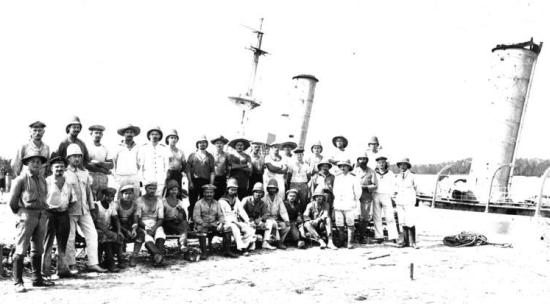
Salvage Crew at the
wreck of the SMS Königsberg
Photograph by Walther
Dobbertin from Bundesarchiv /
WikiCommons
In July 1915 all of
the
ten 10.5cm guns of the SMS Königsberg were recovered
from the ship's wreck and dragged on carts made from
farm machinery over 100 miles
overland by African porters to Dar Es Salaam. There
they were refitted at the railway workshops and prepared for use on land.
Initial Deployments of the
Guns as Coastal Artillery
The guns were
initially deemed most suitable as coastal artillery
overlooking the sea or lakeshores to defend against
potential allied seaborne attacks. In this role all
ten guns were originally deployed on their original
naval pivot stands. Five guns were installed at Dar
Es Salaam, two at Tanga and three were sent to the
Western Front of German East Africa.

Initial Deployment of the Guns
Dar Es
Salaam Deployment
Five of the guns
were installed in fixed emplacements to defend the harbour at
Dar Es
Salaam in two batteries (Batterie Müllerschamba next
to the railway station with three guns and Batterie
Kurasini across the Seresan Creek above the harbour
with two guns). Both batteries covered the deep
water approach to the harbour.
As we know
by deduction that two of the guns based at Dar Es
Salaam were originally turreted guns on the SMS
Königsberg and that three were not. It is tempting
to believe that the two batteries were divided in
this way with
Batterie Müllerschamba
being turreted and Batterie Kurasini being
unturreted and possibly built into
blockhouses as seen in some photographs
of the emplacements after their capture by allied
forces in September 1916. There is however no
corroborating evidence for this theory.
The guns
were gradually withdrawn one by one from Dar Es
Salaam between March and August 1916 as they were
needed on other fronts and as the allies under Smuts
eventually drew closer to Dar Es Salaam itself.
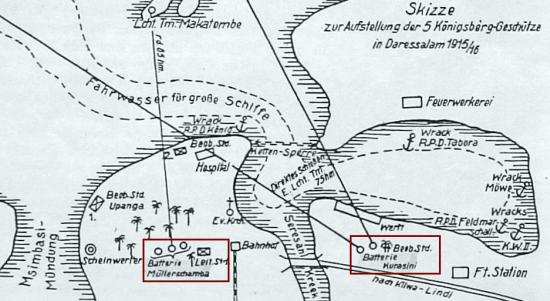
Map of Dar Es Salaam
Harbour, Showing the Position of the Two Gun
Batteries
An
eyewitness, Nis Kock described the response of a
single 10.5cm Königsberg to a British naval raid on
Dar Es Salaam. The British were shelling the city
from three or four ships-
"But all at once, one of the long range Königsberg
guns began to make itself heard; its emplacement was
behind the town but its fellow had already been
taken off to one of the fronts. I saw slender spurts
of water rising round the English ships, like
innocent fountains on the shining sea. But the
English knew what these tall thin springs of water
meant, and they altered course and stood out to sea
but still kept up their fire. The Königsberg big gun
followed them faithfully and her shells fell
annoyingly near. I couldn't see whether there were
any hits on account of the ships smoke which hid
them almost completely".
(Quotation
from "Blockade and Jungle" by
Nis Kock, edited by Christen P Christensen, Battery
Press 2003)
Tanga Deployment
Two of the guns
were deployed to Tanga to defend the harbour there.
These guns were mounted on platforms on rails. Both
guns were fitted with their original turrets.
"The guns set out in Dar Es Salaam were
stationary- they were placed on concrete platforms.
Those used in Tanga were different. The gun at
Nyamyami was constructed within a building (a grass
hut) and was transportable.
The gun at Putini was
mobile on a 6km long railway track in order to fire
up Tanga and Manza Bay simultaneously."
(Quotation from P34, Vol 3
"Kriegserinnerungen aus DOA
1914-1917" by Hermann J Müller, Privately Published)

Gun
in its Emplacement at Tanga c1915-16
Photo
originally published in
"Geraubtes Land" by
Werner Schönfeld
Westwards
Deployment
The other three
guns were sent Westwards on the Central
Railway to Tabora.
From there one went north to Mwanza on Lake Victoria
and two carried on along the railway further west to Kigoma on Lake Tanganyika,
where one was used as coastal artillery and the
other was mounted on the lake steamer SS Goetzen.
The guns at Kigoma and on the SS Goetzen had their
original turrets.
The gun
at Mwanza which did not have a turret and so improvised a gun
shield in its place.
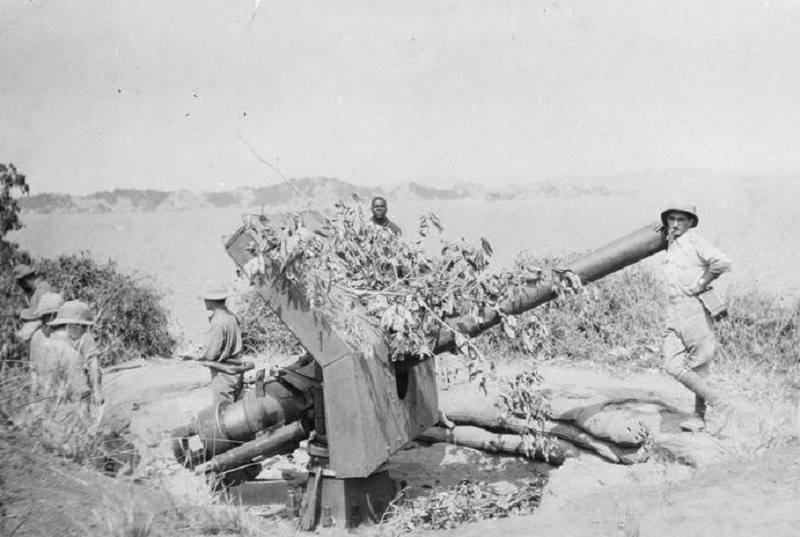
Captured Gun in
Emplacement at Mwanza, 1916
Photo
©
Imperial War Museum
Blockade Running
Supply Ships
The Königsberg guns would have
soon run out of ammunition if it had not been for the arrival of two blockade running supply ships
in German East Africa, the SS Kronberg and the SS
Marie both carrying 10.5cm shells and well as
other much needed supplies and munitions.
SS Kronberg
The first of the blockade
breakers to reach German East Africa was a
cargo steamer named Rubens that was impounded at
Hamburg in 1914. Renamed the SS Kronberg, she was
captained by
Oberleutnant
zur See der Reserve Carl Christiansen and manned by
a hand picked crew of sailors from the Imperial Navy
who spoke fluent Danish. These men were mostly from the
ethnically Danish North Schleswig, which was at the
time part of the German Empire.
The crew
were not told of their mission until they had left
Kiel and were out to sea. They were told to discard
their German naval uniforms in favour of civilian
seamen's sweaters. Nis Kock, a stoker
on the ship recalled that Christiansen then gathered the ship's
crew and said-
"I can
now tell you the object of this voyage. It is to run
the English blockade and take supplies of coal and
ammunition to the SMS Königsberg. I had to keep this
absolutely secret till this moment on account of the
spies which unfortunately abound in Wilhelmshaven...
we hope to keep clear of English and French ships
but if nevertheless we are stopped, I hope every man
understands what that means. You are now Danish
seamen!"
(Quotation
from "Blockade and Jungle" by
Nis Kock, edited by Christen P Christensen, Battery
Press 2003)
The Danish
flag was flown from the ships mast and a portrait of King
Christian X of
Denmark was hung in the mess. The deception did
prove effective when they were stopped and inspected
by a British Royal Navy ship and successfully
passed themselves off as an innocent Danish merchant vessel.
The Kronberg
sailed across the North Sea to the coast of Norway, around the
south of Iceland, down the Atlantic, around the Cape of Good Hope and on 14
April 1915 arrived at Manza Bay, north of Tanga. By
this time, the Royal Navy had intercepted wireless
messages between the SMS Königsberg and the Kronberg
and knew of her presence. HMS Hyacinth was deployed
to Manza Bay where she began shelling the Kronberg
from a distance to be safe from return gunfire from
the shore.
Christiansen
then ordered the Kronberg to be burned, scuttled and
abandoned.
The wooden beams on the deck were set ablaze and she
sank in shallow water. HMS Hyacinth then
considered her task done and returned to Zanzibar.
With the
Royal Navy gone, teams of
divers from the crews of the SS Kronberg and SMS Königsberg set
about salvaging the ship's cargo. In all
they managed to retrieve the following useful
supplies-
1,800 Mauser 98 rifles
(Kar98az).
Four MG08 machine guns.
4.5 million rounds for the rifles and machine guns.
Two 6cm naval landing guns.
3,000 6cm shells for the landing guns and the other
three 6cm guns already in East Africa.
1,000 10.5cm shells for the large SMS Königsberg
guns.
500 8.8cm shells for the two smaller SMS Königsberg
guns.
3,000 3.7cm shells for the revolver guns from the
SMS Möwe.
·
One ton of Trinitroanisole explosive. ·
Telegraph and telephone material, medical supplies,
machine tools, cutting torches, uniforms, two
hundred tents, rations and other minor items.
The one
thousand rounds for the Königsberg guns were
essential for the continued usage of the guns on
land. They were well packed on board the ship and so
suffered little water damage by the time they were
salvaged. The rifle and machine gun rounds were
however damaged and many had to be taken apart and
reloaded in Dar Es Salaam. Even then they suffered
high incidences of misfiring.
The crew of
the Kronberg were then incorporated into the
Schutztruppe with many Danish names appearing in the
list of the last Schutztruppe survivors to lay down
their arms after the European armistice of November
1918.
SS Marie
The second blockade runner was sent to East Africa
as a response to a message sent back to Germany with a wish list of
supplies, among those were some gun carriages for
the Königsberg guns.
Within a month of the receipt of the message the mission was on its way.
For this
voyage another British built steamer
was chosen. She was formerly named the Dacre Hill
but had been taken into German service
as the Sperrbrecher 15 and was now renamed the SS Marie
for the mission from Wilhelmshaven to German East Africa.
As it had worked so well before with the SS
Kronberg, the same ruse of pretending to be a Danish
merchant vessel and following a similar route was
used again. This time however, the ship's captain,
Leutnant z.S. d.R.
Conrad Sorenson maintained
complete radio silence throughout his mission.
Around 18
March 1916, she arrived at Sudi
Bay near Lindi in the south of German East Africa near the
border with Portuguese Mozambique having completely evaded
the allied blockade. The news even came as a
complete surprise
to von Lettow-Vorbeck's Schutztruppe who had no idea that it was
coming either. In fact, when the Marie was first
spotted she was fired upon by a Schutztruppe coastal
battery.
With the confusion soon
cleared up, Sorenson was greeted by the Lindi
District Commander, the former Königsberg navigation
officer
Leutnant z.S. Hinrichs and the local
Schutztruppe commander Hauptmann Paul Kaiser.
Together they planned the work needed to unload the
cargo of the SS Marie, unhindered by the Royal Navy. Sorenson
even had his own pontoon bridge system with him to
assist. The cargo of
the SS Marie consisted of :
2,000
Mauser G98 rifles (Kar98az).
Six
MG08 machine guns with telescopic sights.
Four 10.5cm howitzers.
Two 7.5cm mountain guns.
Unknown number of artillery shells, including 10.5cm
rounds.
3 million rounds of ammunition.
2,000 rifle grenades
1,500 hand grenades
Four Krupp gun carriages intended for the 10.5cm
guns of the SMS Königsberg.
Medical supplies (including 200 kilos of quinine),
rations, uniforms and equipment packed as 50,000 porter loads.
Luxury items such as sweets and also a quantity of
medals for von Lettow-Vorbeck to distribute and
award (One hundred first class Iron Crosses with
recommendations for von Lettow-Vorbeck, Schnee and
Looff, one thousand second class Iron Crosses for
members of the Konigsberg crew and the Schutztruppe
and 2,425 Kriegerverdienstmedaille of various
classes for the askaris).
To accompany the
10.5cm howitzers was an artillery officer,
Hauptmann Roland
von Kaltenborn-Strachau who remained with the guns
and served with the Schutztruppe.
Especially useful for the Königsberg guns
were the Krupp gun carriages which enabled four of
them to become mobile and of course the 10.5cm
shells.
The new 10.5cm shells
on the SS Marie were shrapnel shells with a timed fuse (known as
Brenn Zünder
or BZ) so that the shell exploded in mid air over a
target, rather than the original armour piercing
rounds of the Königsberg which were less useful on
land.
Several weeks of work
went into unloading the cargo before the Royal
Navy's HMS Hyacinth arrived having heard reports of
another ship having arrived. She fired at the Marie
and returned in strength with more ships a few days
later for a three hour bombardment of the Marie.
Seeing their target ablaze, the Royal Navy did not
venture closer to confirm their kill.
Amazingly, after the
raid Sorenson
and his crew off-loaded the last of their supplies
and made good their
repairs in ten days. The SS Marie then sailed away from German East Africa,
through the British blockade and across the Indian
Ocean where they docked at Batavia on 16 May 1916 in the neutral
Netherlands East Indies (modern Jakarta in
Indonesia) and were interned there for the rest of
the war in relative comfort.
The supplies that
they left behind were
crucial for the Schutztruppe's ability to carry on
the war throughout 1916 and 1917. The Schutztruppe
were now able to equip most of their askaris with
1898 model rifles, the ammunition for which lasted
them up until around October 1917. Soon after they
captured large quantities of Portuguese weapons and
ammunition.
Gun
Carriages
In 1916 with the allies on the offensive and the
Schutztruppe in retreat, the Königsberg guns had to
become mobile. Three distinctive types of gun carriages
have been used for the guns. One type was improvised in Dar Es Salaam
and notably different were the Krupp carriages that had arrived from
Germany on the SS Marie. Confusingly the gun currently on display in
Pretoria has an entirely different type of carriage
using Krupp wheels.
The
different gun carriages had their own methods of
adjusting the elevation of the gun but none had any
mechanism for adjusting the traverse aiming of the
gun. This was done by manually moving the tail of
the carriage to the left or right.
The recoil
dampers were kept on the guns, these were just as
essential on gun carriages as they had been on ship.
The dampers took some of the recoil of the gun and
thus reduced the tendency of a gun carriage to roll
back when fired. This saved precious time in action
by not needing to reposition the gun after each
shot.
"Now it was time to adapt to new shooting ratios for
use on land. Our guns lacked some technical tools
that were installed on land guns from the outset.
For the lateral adjustment of the gun we fired
alongside our 7.5cm guns (presumably
the 7.5cm Gebirgskanone M08 that had been
brought from Germany on the SS Marie
in 1916). After determining
this direction we could then detect further targets
by lateral improvements to our gun."
(Original quotation from
P41-44 "Lebensbericht 5.
Die Schiffsgeschütze als Artillerie der Kaiserlichen
Schutztruppe" by Hans Apel, unpublished personal
memoirs)
I. Dar
Es Salaam Improvised Gun Carriages
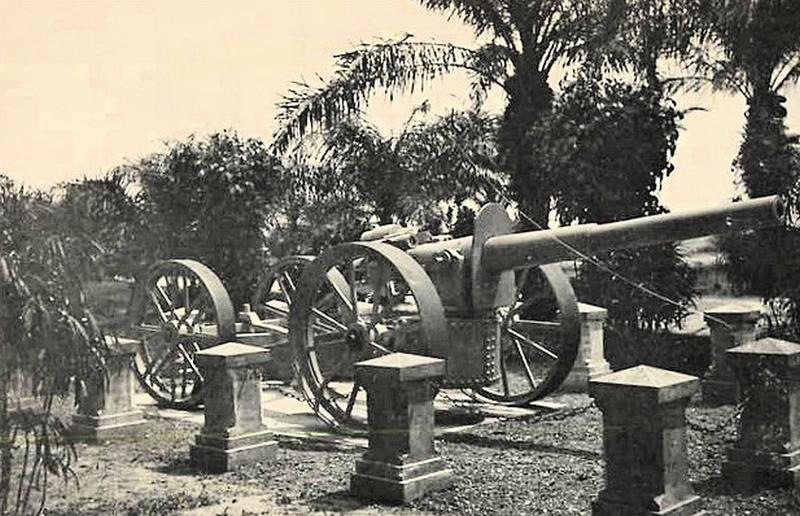
The Former Goetzen Gun on display with a Dar Es
Salaam Improvised Carriage in the
Belgian Congo c1930s-early 1950s
Note the low slung rounded riveted carriage
tapering toward the tail, the
multi spoken wheels and the gun limber in the
background. This limber has sixteen spokes,
whereas other limbers seen in period photographs
only have eight.
Photo ©
Stanleyville.be
Realising
that the guns may one day need to be mobile the
Königsberg gunnery officer and gun commander at Dar
Es Salaam, Oberleutnant z.S. Hans Apel, the
Schutztruppe's artillery officer Oberleutnant d.R.
Karl Häuser
and the chief naval engineer in Dar Es Salaam began
designing gun carriages for them based on what
limited parts they had available.
These gun
carriages were then made in the Dar Es
Salaam railway works from parts of
steam trains and requisitioned farm machinery. The
large gun carriage wheels
were obtained from LANZ
Lokomobile steam traction engines. They had 14
tangentially laced spokes. The smaller 8.8cm guns
and the limbers for all guns also used wheels from
similar farm machinery.
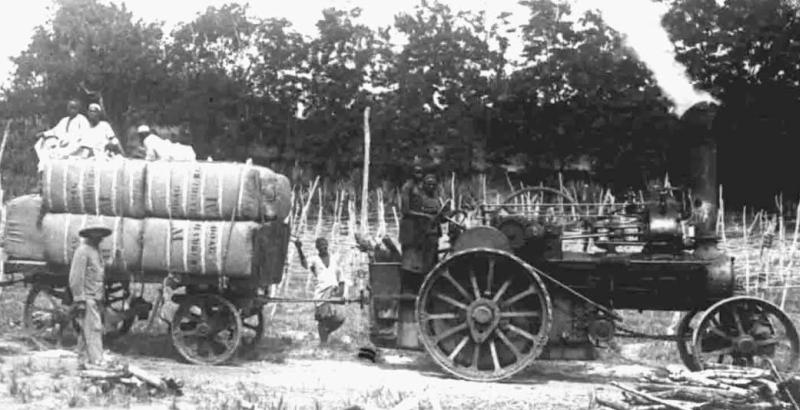
LANZ Steam
Traction Engine on a Plantation in German East
Africa
Photo originally appeared on the
Panzer Forum
The first of
these gun carriages was given to the gun sent from
its fixed position in Dar Es Salaam to reinforce the
northern front in March 1916. This
Gun was later captured near
Mkuyuni. A second carriage was sent to Kigoma
for the former SS Goetzen Gun
later captured by the Belgians at Korogwe. A third Dar Es
Salaam gun carriage was given to
Apel's Gun which was later
captured at Kibata. The
8.8cm Königsberg Gun captured
at the Battle of Mlali also had a similar Dar Es
Salaam made carriage.
The
Dar Es Salaam carriages had a rounded blunt front nose and were
low slung in that they sat mostly below the wheel
axle. The nose of the carriage sat horizontally the
tails tapered down and met at the base. The carriage
had a folding platform on either side of the tails
for the gunners to stand on. One period photo shows
the gun captured at Korogwe with a Dar Es Salaam
carriage with brake blocks on the front side of the
wheels. It is not know if this was a standard
fitting on the guns. The Dar Es Salaam made
carriages used the existing gun bucket from the
naval pivot stands to attach them to the carriage.
Being home
made, not all the Dar Es Salaam carriages were
identical. The gun captured at Korogwe had a riveted
seem at the front, while the one captured at Mkuyuni
had a smooth front. It is likely that close
examination would have revealed further differences
between the individual carriages.
These
carriages were used on at least three of the ten
10.5cm Königsberg guns (those that were captured at
Mkyuni, Kahama-Korogwe and Kibata) and the 8.8cm Königsberg gun
captured at Mlali Pass. Only the carriage of the
8.8cm from Mlali survives today.
DAR ES SALAAM GUN CARRIAGES
All the
photographs below clearly show the guns with multi spoked
wheels and low slung riveted gun carriages with
blunt rounded fronts and tampering tails.
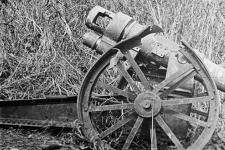
Gun captured at the River Ruaha |
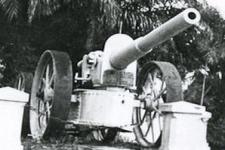
Gun in Stanleyville, Belgian Congo
|
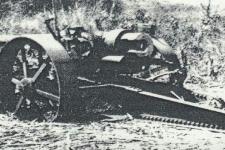
Apel's Kibata Gun |
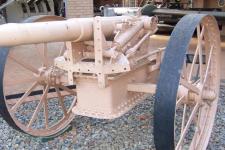
8.8cm
Königsberg Gun |

Advertisement for Lanz
Traction Engines
II. Krupp
Gun Carriages
As described above in March 1916, the supply ship SS Marie arrived at Sudi
Bay in German East Africa from Germany with supplies
of ammunition, weapons and four new Krupp gun
carriages for the former SMS Königsberg guns.
These Krupp
carriages were not standard ones for standard land
weapons, they were made specifically to mount naval
guns on land. Carriages such as these had already
been used for naval guns in the Dardanelles campaign

10.5cm Feldkanone L/35
on a Krupp Gun Carriage,
Germany
Note straight
carriage, gun shield, sighting post and the
eight strutted wheels with their original
comparatively thin rims. Note also the attachment in
the circular hole by which the gun could be moved.
It seems these attachments were either not delivered
to Africa or discarded there.
Photo originally appeared on the
Panzer Forum
Some modifications had
to be made to the carriages before they were
suitable for use in East Africa. One of the battery
commanders at Dar Es Salaam Hans Apel described the problems and
their solutions-
"These
new carriages sent from home were heavy vehicles
with shields, well suited for solid European roads
and strong draft animals. However, for the road
conditions in the bush, they proved not to be very
suitable. The shields were removed and
made into much-needed protection for machine guns.
We attached 25cm wide iron bands to the very narrow
wheels. They provided some assurance that the
vehicles did not sink too deeply into sandy and
muddy trails. After their reconstruction with Dar es
Salaam guns, two were immediately sent to the front
(most likely the gun later destroyed at
Kondoa-Irangi and that sent to Bagamoyo) and a third
carriage without a gun was sent to Kigoma (and later
captured outside of Tabora)."
(Original quotation from
P40 "Lebensbericht
5. Die Schiffsgeschütze als Artillerie der
Kaiserlichen Schutztruppe" by Hans Apel, unpublished
personal memoirs)

Königsberg Gun with a
Krupp Gun Carriage at Mombasa
Note the specially widened wheels eight strutted wheels and
the straight heavy gun carriage.
Photo © Kevin Patience
The gun
carriages were of a design commonly seen on German
artillery of the period. They were more robust than
the carriages made in Dar Es Salaam but consequently
heavier.
Unlike the
carriages made in Dar Es Salaam which had a rounded
blunt nose, the Krupp carriages were flat. While the
Dar Es Salaam carriages were low slung, the Krupp
ones sat above the axle. The Dar Es Salaam carriages
tapered down towards the tail while the Krupp tails
were straight and parallel, separated by steel
plates.
The Krupp
wheels had eight struts rather than the laced spokes
of the Dar Es Salaam traction engine wheels. As
mentioned above, the
original wheels were too thin for the terrain of East
Africa and engineers in Dar Es Salaam fitted 25cm
steel bands to widen them for African soil. These
25cm steel bands around the wheels can still be seen
on the surviving examples of Krupp wheels for
Königsberg guns at Mombasa and Pretoria.
Whereas the
Dar Es Salaam made carriages used the existing gun
bucket from the naval fixed mounted to attach them
to the carriage the Krupp carriages had their own
gun mountings so did not use the ship's original gun
bucket. The photograph below shows the naval pivot
stand of a 10.5cm Königsberg gun at Dar Es Salaam
shortly after the allies occupied the town in
September 1916. Note that the gun bucket with
fixtures for the barrels' trunions and elevation
system are still present. This tells us that the gun
removed from this stand was not put onto a Dar
Es Salaam made carriage but a Krupp Carriage. The
fact that the gun bucket has bolt holes in it shows
us that this gun originally had a turret.
It is clues
like this that helped us track down the history of
the Konigsberg guns and identify their photographs.

Mounting base
of a Gun at Dar Es Salaam
This photograph shows one of the
abandoned gun emplacements at Dar Es Salaam captured by
the British in September 1916. The five guns were all
put onto gun carriages and sent to different fronts
before the city was captured. The gun bucket being among
the remains shows that this gun went onto a Krupp gun
carriage as the carriages made in Dar Es Salaam required
the pivot stand's gun bucket. From the fact that there
are bolt holes in the side of the gun bucket for
attaching the turret, we know that this gun must have
had a barrel flange. Therefore this is the
stand for one of the guns later captured at either Bagamoyo or Mahiwa.
Photo by CH Grenfell ©
Imperial War
Museum
Other unique
features of the Krupp carriages were an aiming post
of the left side, fixed gunners platforms on either
side and a detachable shield for the gunners with a
sight hole on the left side. As stated by Hans Apel
above, the gun shield was sometimes
discarded as being too heavy and was sometimes used
on fixed machine gun emplacements instead. The guns
used at Kondoa-Irangi and Bagamoyo both still
retained
their guns shields.
The
carriages seem to have arrived without limbers as
period photographs show them coupled up to limbers made from
farm machinery in Dar Es Salaam.
The four gun
carriages were used on the guns lost at
Kondoa-Irangi, Bagamoyo,
Mahiwa and Masassi. The carriages of the guns
captured at Bagamoyo, Mahiwa and Masassi have all
been accounted for. The fate of the Kondoa-Irangi
Krupp carriage
is unknown except that it was reported as damaged.
The Gun from the Elephants Foot in Kigoma was also
reported to have had a Krupp carriage by Apel, so it
may be that gun used the carriage from the first
Kondoa-Irangi Gun or at least some parts of it to
make a working carriage. Unfortunately no
photographs of the Kigoma gun have been seen of its
mobile service.
One of the Krupp
carriages still survives at Fort Jesus, Mombasa in
Kenya. The wheels of another are on the gun at the
Union Buildings in Pretoria.
KRUPP GUN CARRIAGES
All
the photographs below clearly show the guns with
eight strutted wheels and straight gun carriages
with right angled cross struts bracing them.

Gun at Bagamoyo |
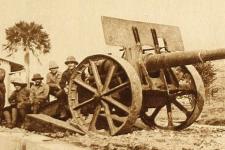
Kondoa-Irangi Gun |
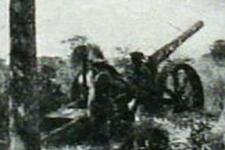
Wenig's Gun at Mahiwa |
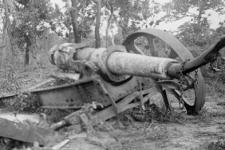
Last Gun at Masasi |
III. Pretoria Gun Carriage
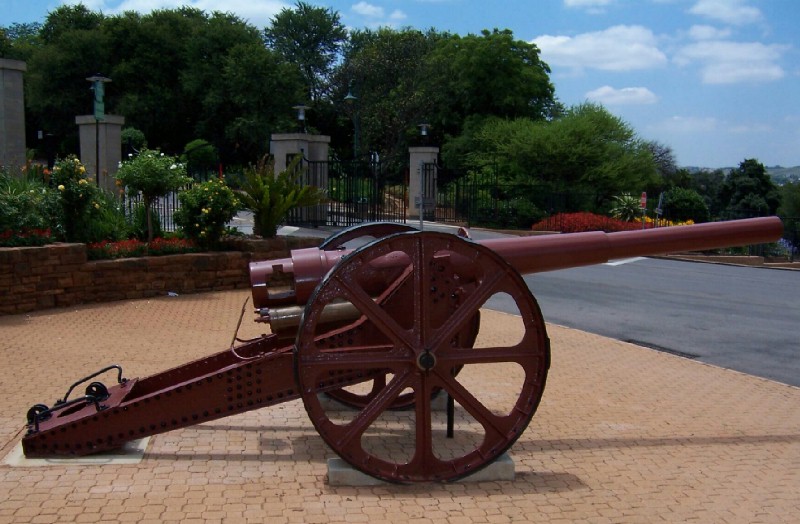
The Pretoria Gun
Photo © MC
Heunis
The gun on display at
the Union Buildings in Pretoria has a unique hybrid
gun carriage. It has widened Krupp wheels but the
carriage itself is not of Krupp design, is roughly
welded and may have been made by the Germans in
wartime conditions. The exact origins of this gun and its carriage
are as yet uncertain.
Gun Limbers
When moving the guns on their carriages a gun limber
was needed, as a set of wheels to support the tail
of the gun carriage. Various types of improvised gun
limbers have been seen usually made from the same
farm machinery as the gun carriages also made in Dar
Es Salaam, thought their variously designed wheels
are smaller than those on the gun carriages. The gun
captured at Bagamoyo and later seen in Hove, England
appears to have used an old C73 gun carriage as its
limber. The SS Marie does not appear to have brought
Krupp made limbers to accompany the four Krupp gun
carriages that she brought.
Wartime Painting of the Guns
The illustration
below by W Rehfeld, is most likely an eye witness sketch. Rehfeld did
serve with the Schutztruppe in East Africa during the First
Word War and made many water colour illustrations of life on
campaign there. This painting is far too accurate in it detail
for it too be anything other than an eyewitness painting. From
the spoked wheels, lack of a gunner's sighting arm and low riding
carriage it would appear that this illustration shows a gun on
one of the Dar Es Salaam made gun carriages. It also clearly has
no barrel flange meaning that it was not an originally turreted
gun. This combination of features means that the gun illustrated
here is most likely either the gun abandoned near Mkyuni on the
River Ruaha in August 1916 or Apel's gun that was abandoned near Kibata in
January 1917.
Interestingly it looks as though the
artist has coloured the gun in black. On board ship the
guns would originally have been painted a pale navy grey and the
Krupp carriages that arrived on the SS Marie would most likely
have been in a factory finished dark grey, as standard for the
German army at the time. The guns were later repainted in different darker colours for their land
service. Indeed, August Hauer, a Schutztruppe doctor recalled
the gun lost at the Battle of Kondoa-Irangi as
"sprawled
black and stiff", when he saw it at Dodoma
on its way into action.
(Quotation from "Kumbuke,
Kriegserlebnisse eines Arztes" by August Hauer,
Deutsch-Literarisches Institut J Schneider, Berlin-Tempelhof
1935)
The gun on display in London and
Hove in the 1920s is seen as very dark, possibly black in
monochrome photographs of the period though this may have been
applied after capture. The gun on display in the Belgian Congo
up until the 1970s was painted green, though again this may have
been a post-war coat of paint. The gun on display at Jinja,
Uganda today is painted black but was seen in green in the
1990s. Both of these colour schemes were probably added after
the gun's capture at Mwanza and indeed some of the original
naval grey can been seen below chipped parts of the modern
paintwork. The gun on display in Mombasa is painted in naval
grey, this was added during restoration in the 1980s.
MC Heunis said that when paint samples
were taken from the gun on display in Pretoria is was deduced
that the gun had probably been a dark reddish brown in wartime,
possibly from stocks of paint in the Dar Es Salaam Railways
works. The gun at Pretoria has since been repainted in a
recreation of this reddish brown shade.

10.5cm SMS
Königsberg Gun in the Elephant's Foot Emplacement at
Kigoma c1915-16
This photograph shows the gun with its
original naval pivot stand and turret. Note that
some form of rough camouflage paint appears to have been
applied to the turret and barrel.
Some wartime black and white photographs such as those
taken at Kigoma appear to
show mottled patches or stripes of what may be camouflage patterns
of light and dark colours. Other photographs and eyewitness
accounts tell of wartime African paint quickly peeling off the
guns in the tropical heat to show the original naval grey paint below. By 1917 Oberleutnant z.S.
Richard Wenig described the gun under his command as "rusted,
the paint peeled off and missing through the years, an old
veteran with bent spokes and some blasted rivets."
(Quotation from "In Monsun und Pori
Safari" by Richard Wenig, Verlag, Berlin 1922)
There were almost certainly stocks
of black paint at the railway works at Dar Es Salaam for the
upkeep of their black locomotives and rolling stock. Shipping dockyards such as
that at Kigoma would most likely have had stocks of black and
also grey or white and reddish brown to paint respectively above and
below the plimsoll line. Both of these sources would also have
had basic primary colours for details and lettering. If yellow
were added to the reddish brown a useful khaki colour could
easily have been made. If green were added, an olive drab could
be improvised.
In summary it seems that many
different paint schemes were used on the guns in wartime. They
would have been naval grey when originally on the ship. Further
coats were added in wartime to replace worn paint or to give a
more camouflage effect. These locally added schemes would have
been improvised based on mixtures of whatever basic paints the
German had to hand and may have varied drastcally.
Weaknesses of the
Guns and Assessment of
their use on Land
Despite for some time being the largest guns owned
by either side in the East African campaign, they
were rarely decisive in action on land. The
Königsberg's
guns had proven deadly to the HMS Pegasus at sea and
they defended coastal positions well in deterring enemy
ships from approaching but their use during the
on-going land campaign was
limited by two factors: their relative immobility
and a limited supply of ammunition.
Transportation of the Guns
The main weakness of the Königsberg guns on land was their
immobility. While the
Germans were able to defend their borders the guns
were useful in defensive positions. From 1916 when
the war in East Africa became more mobile and the
Schutztruppe went into retreat the guns often became
a liability. This is mentioned in veterans' diaries
time and again-
"Unfortunately, we did not have
more than eighty four porters for the heavy
artillery and we needed to continue to Killimamzinga. Because
of this lack of manpower it was a
sad journey,
having to
drag the heavy artillery
through the sand
and
over
hill and dale."
(Quotation from Vol 3
"Kriegserinnerungen aus DOA
1914-1917" by Hermann J Müller, Privately Published)
"We recognized the
limitation of our guns. Accordingly, the
idea of allocating a gun to a fast moving formation had
to be abandoned."
(Quotation from
P41-44 "Lebensbericht
5. Die Schiffsgeschütze als Artillerie der
Kaiserlichen Schutztruppe" by Hans Apel, unpublished
personal memoirs)
"The 10.5 cm gun was already
written off by us as a loss because it was no longer
transportable due to a lack of draft animals. As a
kind of abandoned scarecrow it could only serve as a
bulwark to hold down the Belgians for as long as
possible."
(Quotation from "Hptm. Wintgens Rueckzug von Ruanda nach Tabora und
die Kaempfe um Tabora" by Bruno Koppe, Koloniale Rundschau, Leipzig 1919)
Whenever
possible the guns were transported by rail, for
example from Tanga to Kahe or Dar Es Salaam to
Tabora and Kigoma. When rail was not an option then
the transport of the guns became very difficult.
Even with gun carriages it was an immense effort to
drag them across rough African terrain.
Often it was
easier to dismantle the gun and carrying the barrel
on a Boer cart. Easier there is used as a very
relative term, as dismantling the gun meant making a
makeshift hoist to lift the weight of the barrel
(over 1000kg) on
and off its carriage.
Around two hundred African
porters (depending on the terrain) were then needed
to pull each gun. Another porter was needed to carry
each round of ammunition. Sometimes oxen or draught
horses were used to pull the guns. Supplying and feeding such
manpower or animals put additional strain on the already
limited German resources.
When a gun
could no longer be moved because of difficulty of
terrain or lack of manpower, it had to be destroyed
and abandoned by the Germans in face of allied
advances.

10.5cm SMS Königsberg Gun being dragged on a Sled by
hundreds of African Porters, Kigoma 1915
Photo by
Kapitän Zimmer
©
Frankfurt University Koloniales Bildarchiv
Ammunition
Shortages
Shortage of ammunition was always a problem too. The
Germans simply could not afford to keep enemy
positions under constant barrage. Instead the
ammunition was eked out over three years of warfare
at sea and on land.
The SMS Königsberg left Kiel for
German East Africa in 1914 with
1,500 high explosive 10.5cm shells. With a well
trained crew
the guns
could each fire up to fifteen rounds per minute so it would have been possible to
fire all the guns initial ammunition in ten minutes.
She fired a few rounds in training off the East
African coast when war was looming and another few
during her short raiding career shots were used
to sink the Winchester). Perhaps they used less than
fifty rounds in total on these minor actions.
The action at
Zanzibar where HMS Pegasus was sunk used 276 rounds, while the action in the
Rufiji
before the Königsberg was sunk used around 900
rounds. This would have brought her ammunition
stocks down to around 300 had it not been for the
Rubens bringing 1,000 shells in April 1915.
Reportedly, 450 rounds
were salvaged from the wreck of the SMS Königsberg.
Some of the Rubens supply may still have been ashore
at this time. All in all
the guns probably started the campaign on land with
only a hundreds rounds each.
Both the
Rubens and Königsberg supply of shells were also
water damaged to some extent. The shells
were taken to Dar Es Salaam, cleaned up, dried off
and no doubt re-loaded in some cases (as was a lot
of small arms ammunition that arrived on the
Rubens). It is not recorded exactly how many shells
were salvaged in this way but it is also likely that
many would have been duds by this stage and indeed
the mis-firing gun at the Battle of Kondoa-Irangi
may have been due to water damaged ammunition.
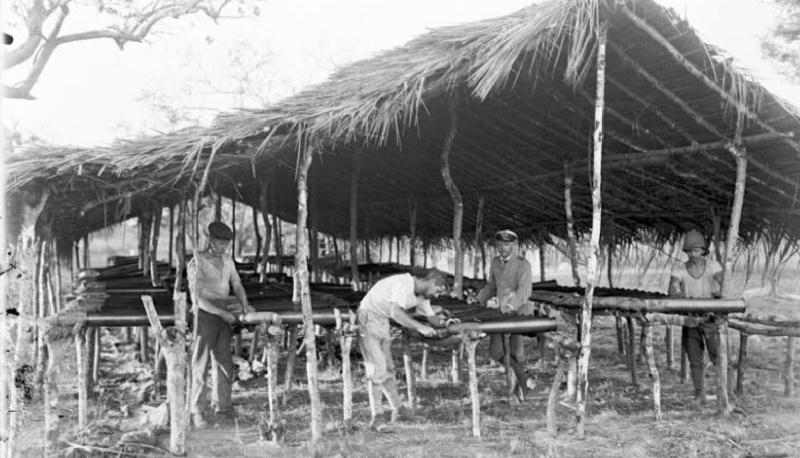
German
Naval Crew Cleaning and Drying 10.5cm Shells from
the SMS Königsberg
Photo by Walther Dobbertin from Bundesarchiv /
WikiCommons
In
March 1916, the
blockade running ship, SS Marie
arrived off the coast of German East Africa with
more supplies including more 10.5cm shells.
Unfortunately this cargo of shells was also water
damaged by the time it could be recovered. The
shells were carefully taken apart, dried, reloaded
and distributed to the remaining guns.
Both the
guns abandoned at Kahama-Korogwe and Mahiwa are
reported to have fired off their last rounds before
being destroyed
and several others may have been in a similar
situation although the gun at Bagamoyo was captured
by the British with eighty shells and the gun at
Mwanza with 400 shells (according to
Major J J Drought's diary
at the
Axis History Forum).
Even when a gun had a plentiful supply of
ammunition, one porter per round was needed to
transport it. There were occasions when the
Schutztruppe did not have enough manpower to
carry the shells. Four hundred 10.5cm shells were
captured by the British as they overran a
Schutztruppe ammunition dump that the Germans were
unable to move at Mlali in August 1916 (see
Soldier 's Burden).
Von Lettow-Vorbeck
described the general shortage of ammunition
suffered by the Schutztruppe in 1917:
"During the last few months the lack of artillery
ammunition had become so serious that we rarely had
more than three hundred rounds all told. That was
about the allowance per engagement for one of the
numerous English guns"
(Quotation from
P128 'Reminiscences of East Africa' by Paul von
Lettow-Vorbeck, Naval &
Military Press Ltd 2004)
as
Another
point on the ammunition is that the
armour piercing high explosive rounds were designed
to sink battleships. They were not especially
suited to infantry warfare and often simply sank
into the soft African soil without exploding.
ES Thompson, a South African machine gunner at the
Battle of Kondoa-Irangi in 1916 recalled in his
diary, "28 May-
As it is Sunday the Germans only shot 3 shells
into the town, only one of which burst"
(Quotation from Vol 7 No 5 ,
P 3 "A Machine Gunner’s Odyssey Trough German East
Africa: January 1916- February 1917'
by
ES Thompson, South African Military
History Journal)
Target
Identification
At sea, the gunnery officer on the bridge would
identify a target and set coordinates. On land,
observers were needed. Ideally, an observer
(sometimes the gun commander) would set up position
on a hilltop over looking the target and relay
coordinates and corrections to the gun team by field
telephone. Under these conditions the accuracy of
fire could be almost guaranteed.
Conditions
in the field when the guns were mobile were however
not always so favourable. Often observers could not
get into position to see the enemy or communications
between them and the gun team were lost. Under these
conditions the accuracy of fire could not be
guaranteed as guns would have fired at set targets
where they hoped the enemy may be or blindly in the
general direction of the allied advance.
Allied
artillery often had the advantage of spotter planes,
which the Germans were without, having lost their
only aircraft (an Otto/AGO Pusher Biplane piloted by
Bruno Büchner) long before the Königsberg guns took
on a mobile role.
Allied Reports of the
Effectiveness of the Guns on Land
Reports are
mixed as to the effectiveness of the guns from the
view of the enemy. When ammunition was plentiful and
targets were properly spotted the guns could provide
a terrific bombardment. Major Lewis of the 129th
Baluchis Regiment of the British Indian army
reported this experience of a bombardment from a
Konigsberg gun near Kibata- “An
hour before dark, this developed into an intense
bombardment, and except for the size of the shells,
I never experienced such a hot one, even in France. We lost heavily in the redoubt however our
men stuck it like heroes, though there was little
left of the trenches.”
(Quotation
from Letters of Major Lewis reported on
Kaiser's Cross website)
The Germans
were also able to delay the allied advances with
Königsberg guns as they often out ranged anything the
allies had. This is a description of the action on
30 December 1916 at Duthumi, near the Mgeta river-
"For five
weeks before this British troops had lain passively
in this water logged camp under an irregular but
very accurate, fire from a 4.1 naval gun off the
Königsberg. The range of this gun was about eight
miles. It was so carefully hidden in the bush that
our areoplanes could not possibly spot it, and it
therefore had everything all its own way, as none of
the British guns up at this front, up to date, had a
range of more than four miles"
(Quotation
from P57 With the Nigerians in German East Africa by
WD Downes, Meuthen, London 1919)
While they
certainly caused casualties and acted as a deterrent
to allied advances they did not apparently always strike
fear into the enemy. ES Thompson, a South African machine
gunner at the Battle of Kondoa-Irangi in 1916 recalled
in his diary for 1 June 1916, "At
about 4 o'clock (in the afternoon) an exciting artillery duel
began. Our artillery first opened fire using
shrapnel and the Germans replied with high
explosives. One of their shells landed in the
mountain battery camp but no damage seems to have
been done. Another shell landed in a herd of native
sheep killing a few."
(Quotation from Vol 7 No 5 ,
P 5 "A Machine Gunner’s Odyssey Trough German East
Africa: January 1916- February 1917'
by
ES Thompson, South African Military
History Journal)
The South African commander, General Jan Smuts summed
up the ship and its guns' action in his memoirs- "The
Königsberg
was to be very troublesome for a long while to come,
for the enterprising of Lieutenant-Commander
Schönfeld had salvaged her ten 4.1 inch high
velocity guns. These were to be converted into
mobile land guns and were to outrange our own artillery
throughout the campaign and to harass our men
incessantly."
(Quotation from "General JC Smuts" by JC Smuts, Cape
Town , 1949 at
Archive.org)
Sources and
Links
Original Map from 'A
Short History of the Great War'
by AF Pollard,
Methuen & Co, London
1920
"Blockade and Jungle" by
Nis Kock, edited by Christen P Christensen, Battery
Press 2003
"Fahrt nach Ostafrica" by Knud Knudsen, Otto
Lenz, Leipzig 1918
"With the
Nigerians in German East Africa" by
WD Downes, Meuthen, London 1919
"A Machine Gunner’s Odyssey Trough German East
Africa: January 1916- February 1917'
by
ES Thompson, South African Military History Journal
"Königsberg- A German East African
Raider" by Kevin Patience, Zanzibar Publications,
Bahrain 1997
"Meine
Erinnerungen aus Ostafrika" by Paul von
Lettow-Vorbeck, KF Koehler Verlag, Leipzig 1920
"Kriegserinnerungen aus DOA
1914-1917" by Hermann J Müller, Privately Published
"Lebensbericht
5. Die Schiffsgeschütze als Artillerie der
Kaiserlichen Schutztruppe" by Hans Apel, unpublished
personal memoirs
"Hptm. Wintgens Rueckzug von Ruanda nach Tabora und
die Kaempfe um Tabora" by Bruno Koppe, Koloniale Rundschau, Leipzig 1919
"In Monsun und Pori
Safari" by Richard Wenig, Verlag, Berlin 1922
"Kumbuke,
Kriegserlebnisse eines Arztes" by August Hauer,
Deutsch-Literarisches Institut J Schneider, Berlin-Tempelhof
1935
"Das Offizierskorps der Schutztruppe für Deutsch-Ostafrika
im Weltkrieg 1914-1918" by
Wolfgang-Eisenhardt Maillard and Jürgen Schröder,
Walsrode 2003
"The First
World War in Africa" by Hew Strachan, Oxford
University Press 2004
Major J J Drought's diary
at the
Axis History Forum
"General JC Smuts" by JC Smuts, Cape
Town , 1949 at
Archive.org
Letters of Major Lewis reported on
Kaiser's Cross website
Gustav Zimmer Collection
at
Frankfurt University Koloniales Bildarchiv
The highly recommended
Kaiser's Cross article
on the Blockade Runners
Von Stachau-Kalternborn
biographical information on the
GMIC Forum
NavWeaps
Lovett
Artillery
PassionCompassion1418 More
German guns after the war inc. Krupp carriages
Axis History Forum Discussion on the SMS Königsberg
Guns in English
Panzer Archiv Forum Discussion on the SMS Königsberg
Guns in German |





















